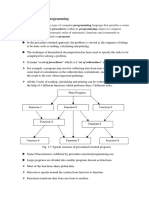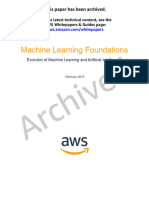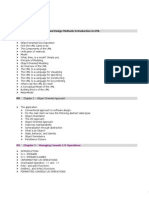Developing Idea Processor (Axon2000)
Uploaded by
G0r9eoDeveloping Idea Processor (Axon2000)
Uploaded by
G0r9eoDeveloping an Idea Processor in Prolog
Chan Bok, Axon Research http://web.singnet.com.sg/~axon2000
ABSTRACT This paper describes the design concepts behind the development of the Axon Idea Processor, a software developed in Visual Prolog to provide an environment for supporting the thinking process. Some of the reasons for using Prolog as the programming language are also explained in this paper. Why Prolog? Ideally the language used for developing an idea processor should be a close match to how the brain works. In this respect there is no close second choice to Prolog. Idea processing is all about problems (logical negation) and solutions (logical assertions), questions and answers, unknowns and facts. Thinking arises when you have no solution or answer to a problem or question. You need not think if you already know. Notice in equation (2) that the arrow (axon) is now replaced by a negation and the or operator. Proving the truth of the equation is the basis of the Prolog language. The backtracking theorem proving mechanism is thus the equivalent of our thinking process. Further development of this theory leads to higher-order hierarchical clusters of selforganizing neurons. These clusters contain feedback (upwards) links, feedforward (downwards) links, and cross links (horizontal) as shown in Appendix B. Predicate logic can best be represented using Ferguson diagrams, where negations and assertions are represented as cell-like, mirrorimage semi circles.
Fig.1 Idea Processing is about problems and solutions, questions and answers, unknowns and facts. Consider a simple neuron receiving inputs A, B, C and producing an output D when the threshold value is 3. The cell activation equation can be represented as: (A & B & C) D ----------------------- (1) This can be rewritten as the predicate logic: ~ (A & B & C) or D --------------------- (2)
Fig. 2 - Ferguson diagram illustrating the close resemblance of predicate logic and neuron activation. With this insight, the Axon Idea Processor commenced development (in 1990) using the DOS prolog compiler from PDC. Since then it has undergone yearly revisions. Thanks to the stability of the language platform, the program has been continuously enhanced using the same prolog language, moving from DOS to 16-bit Windows, then to 32-bit, etc. A Modeless Design A modeless design allows the user to do anything at anytime, without the need to
switch mode. An example of a modeless system is the aircraft cockpit that enables the pilot to simultaneously steer the plane, communicate with control, locate enemy target, fire the gun, etc.
Prompting Tools Our brain is rich in ideas. We recall an idea when a cluster of neurons are activated. One method to improve recall is by prompting. In the laboratory, an electrode inserted into the brain can bring about selective memory recall depending on which cells are activated. Prompting can also arise from visual or textual prompts. For example, looking at the photograph of a person facilitates the recall of this person. In essence, prompting is an effective way to amplify intelligence. Axon provides many prompting tools for both text and graphics, such as the Checklists, Questions, the Random Pictures, the Generator, etc. Diagramming Tools A large portion of the brain (the hind brain) is for visual processing. Vision is by far the most developed of all mental faculties. Our vision also has a longer period of evolution (100 million years) than other faculties such as logical thinking (1 million years, since the ape man). As such Axon is designed to exploit as many visual attributes as possible, such as size, shape, color, textures, depth, and proximity. The recent introduction of GDI Plus in VIP6.3 provides even more visual attributes such as anti-aliasing and curve smoothing. Imprecision is also another useful diagramming attribute that can increase the level of abstraction, distill the generic attributes of ideas, and encourage exploration. Imprecision is implemented using freehand lines, doodles, and symbolic icons. To quote from another researcher, a sketch is not so much vague as it stands for a family of precise models. Fig.4 A sketch is not so much vague as it stands for a family of precise models.
Fig. 3 The cockpits modeless design allows the pilot to do anything at anytime. Examples of other modeless designs are a control room, and an operating theater. As our brain also functions modelessly, so must the idea processor. To be modeless, writing, drawing, organizing, navigating, etc. must be doable at the same time without having to switch modes. This means that the Axons tools must be highly integrated. In contrast, a traditional modal system requires you to enter different modes to perform different functions. Axons Entities An Axon diagram is essentially built from two basic entities - Objects (the nodes) and the Links that connect them. Objects have the functionality for idea processing, such as carrying out an Action and storing text contents. Links show the relation between Objects. (Axon is named after the numerous links which are of great importance). There are other entities such as Shapes (simple geometric drawings found in most drawing software) and Points (which has position but no size). In addition to the basic entities, Axon provides an integrated set of idea processing tools. An overview of the Axon program can best be described as a concept map in Appendix A.
An Axon diagram is multi-layer (i.e. multilevel), and can be viewed as 3D. A tool called the 3D Viewer enables quick switching between 2D and 3D perspectives.
Axon also provides text processing tools such as the Analyzer, and a pre-writing tool called the FreeWriter. The Analyzer, for example, can transform the sentence In the beginning, we may suppose, there was silence into the form:
Fig.5 The 3D Viewer tool provides quick switching between 2D and 3D. Fig 7 The Analyzer can perform text analysis such as sentence parsing. These are typical applications of Prolog. Computing Tools Axon can also compute like a spreadsheet where the cells can be floating, i.e. each cell is identified by name and not its row-column position. An S-Expression parser in prolog can handle the most complex of mathematical expressions. Sometime in the year 2000, it was apparent that Axon's graphical user interface and object-oriented (O-O) design are extremely suitable for simulation modeling. To do this, a new entity called a Packet is introduced. Anything that moves, such as a physical object or a conceptual token, can be represented by a Packet. The concept of a Packet is likened to the Object concept in the O-O sense. (The O-O concept is derived from the early simulation language Simula).
Fig. 6 An example of a 3D diagram where shadows on walls, floors and ceilings provide positional cues. Writing Tools Our brain has well developed faculties for text processing. Writing involves many simultaneous mental tasks such as setting goals, making deductions, constructing sentences, and correcting grammar. Our inability to cope with too many tasks results in mental blocks or even black-outs. Axon allows you to focus your attention on fewer areas, and at a higher level of abstraction. For example the Sequencer tool can be used to sequence ideas at a later stage, thus freeing the mind from sequencing tasks during the initial idea generation stage.
Fig 8 Packets are used by the Simulator. A Packet can reside in an object or move along a link.
The Axon Simulator caters for continuous and discrete event simulation, provides animation and graphical output. It has been successfully used for reliability modeling, facility planning, and medical research.
Conclusion The Axon Idea Processor demonstrates that complex diagramming, writing, text analysis, expression parsing, modeling, prototyping, etc. are all well suited for Prolog programming. Prolog also enables the programmer to work at a high conceptual level near to normal precise thought. The synergy between Axon and VIP Prolog results in a powerful, extensible, and visually appealing system. References [1] A R Luria The Working Brain, Penguin Books.
Fig.9 The Simulator tool supports discrete and continuous event simulation. Packet movement can be visualized as moving dots.
[2] Axon Idea Processor, Axon Research http://web.singnet.com.sg/~axon2000
Appendices
Axon Overview...
Writing Tools
Axon Tools
Prompting Tools
Computing Tools
Sequencer Cluster FreeWriter Analyzer
Tabulator Templates
Slideshow
Checklist Generator Questions Random Random Pictures Words Seq No Draft Report Size Textwindow Textwindow is an has text contents Object connect has attribute ID Shape Link has Label Shape Shape Cluster has attribute Collapse Axon Entity is an is an consist of Color Position has attribute Level
Ticker
Simulator Calculator
Clock Diagram
is an is an Point can be Grouped Packet
Evaluate
can show as Droptext can contain
Hyperlink
has Action
Expression can contain Variable can be a
Key
Entity Attribute Axon Tool Home
Appendix A - A concept map of the entire Axon Idea Processor showing the various entities (as ellipses) and tools (as icons).
The Meat Machine...
The most complex object in this Universe Copyright(c) Axon Research http://web.singnet.com.sg/~axon2000 Meaning/ Judgement
Feeling/ Emotion Control Respond
Strategy Detour Evade... Suppress
Harmony
Grammar
Plan Systematic Trial & Error...
Melody
Sing
Phrase
Spatial Model Diagram My body...
Temporal Model Procedure Event...
React
Primitive Goal Fight/Flee Hunt, Eat Mate...
Chord
Rhythm
Word Noun Verb...
Name
Object Person Place Thing... Object Attribute Shape Size... Image Attribute Edge Motion Color...
Action Walk, Draw, Balance...
Sequence
Other Sound
Musical Note
Phoneme
Letter A, B, C...
Basic Movement Push Lift Turn...
Focus
Tone
Taste
Ears Sound/Speech
Mouth Speech
Lung Larynx Tongue Lip
Eyes Image
Limbs Sensory Motor
Appendix B - A model of the brain showing a combined hierarchical and network structure.
window support windowExtension drawWindow support windowGDI containerW indow predfrom
Class Diagram...
containerW indowSupport
\gui
childW indow
support
\guiSupport
support window drawW indow* inherit containerW indowSupport
\standardControl
containerControl dialog predfrom control predfrom controlSupport userControlSupport containerControl
childW indow documentW indow
frameDecoration
frameDecoration support applicationW indow documentWindow* formW indow inherit taskW indow frameWindow applicationW indow form inherit delegate formW indow messageForm aboutDialog messageControl dialog standardControlSupport button aboutDialog customControl button checkbutton editcontrol groupbox iconcontrol listbox listbutton listcontrol listedit radiobutton radiobuttongroup scrollcontrol textcontrol userControlSupport controlSupport support customControl
Legend
Interface Class support inherit
taskW indow form
messageForm
messageControl
(Examples)
Notes
\messageControl
Appendix C - A Class Diagram of PDCs OOGUI package, based on an early (VIP6.2) version.
You might also like
- Book Abrams Intercultural Communication and Language Pedagogy From Theory To PracticeNo ratings yetBook Abrams Intercultural Communication and Language Pedagogy From Theory To Practice391 pages
- Anti-Languages - M.a.K. Halliday (1976)No ratings yetAnti-Languages - M.a.K. Halliday (1976)16 pages
- Axum Programmer's Guide: Microsoft CorporationNo ratings yetAxum Programmer's Guide: Microsoft Corporation36 pages
- Module 4-Classes, Objects &inheretace-UpdatedNo ratings yetModule 4-Classes, Objects &inheretace-Updated112 pages
- Detailed Study of The Object-Oriented ProgrammingNo ratings yetDetailed Study of The Object-Oriented Programming11 pages
- Natural Language and Inference in A Computer Game: Malte Gabsdil and Alexander Koller and Kristina StriegnitzNo ratings yetNatural Language and Inference in A Computer Game: Malte Gabsdil and Alexander Koller and Kristina Striegnitz7 pages
- Activity 1.4.2 Objects and Methods: 1. Form Pairs As Directed by Your Teacher. Meet or Greet Each Other To PracticeNo ratings yetActivity 1.4.2 Objects and Methods: 1. Form Pairs As Directed by Your Teacher. Meet or Greet Each Other To Practice15 pages
- Unit 1 What Is Object-Oriented Programming?: Structure Page NosNo ratings yetUnit 1 What Is Object-Oriented Programming?: Structure Page Nos11 pages
- Object Oriented Programming Using Java Final Copy With PedagogyNo ratings yetObject Oriented Programming Using Java Final Copy With Pedagogy480 pages
- The Design and Implementation of An Object-Oriented Toolkit For 3D Graphics and VisualizationNo ratings yetThe Design and Implementation of An Object-Oriented Toolkit For 3D Graphics and Visualization9 pages
- Section 1 Object Oriented Analysis and Design Lab: Structure Page NosNo ratings yetSection 1 Object Oriented Analysis and Design Lab: Structure Page Nos27 pages
- Assignment Questions IT-701 (OOAD) : "UNIT-1"100% (1)Assignment Questions IT-701 (OOAD) : "UNIT-1"3 pages
- Introduction To Object Oriented Analysis and Design: Stephen A. SawyerNo ratings yetIntroduction To Object Oriented Analysis and Design: Stephen A. Sawyer12 pages
- Mastering Visualization Techniques for Memory and ComprehensionNo ratings yetMastering Visualization Techniques for Memory and Comprehension7 pages
- Software Development: Problem Solving LogicNo ratings yetSoftware Development: Problem Solving Logic7 pages
- 2) Real Phrasal Verbs - Exercises - EasyNo ratings yet2) Real Phrasal Verbs - Exercises - Easy1 page
- Proiect de Lecție Past Simple Și Past Continous100% (1)Proiect de Lecție Past Simple Și Past Continous2 pages
- Brochure Grading Rubric: Student Name: Date: PeriodNo ratings yetBrochure Grading Rubric: Student Name: Date: Period2 pages
- Za-Hl-587 Grade 6 Grammar and Spelling Vocab BookletNo ratings yetZa-Hl-587 Grade 6 Grammar and Spelling Vocab Booklet18 pages
- Human - Translation - Guideline (EN) - Ver 2.No ratings yetHuman - Translation - Guideline (EN) - Ver 2.16 pages
- Packages: Sudhir Talasila Preeti NavaleNo ratings yetPackages: Sudhir Talasila Preeti Navale25 pages
- Cowley's Essays by Cowley, Abraham, 1618-1667No ratings yetCowley's Essays by Cowley, Abraham, 1618-166775 pages
- The Smart School: Session 2021-22 Subject: English Class: VI Duration 35 MinutesNo ratings yetThe Smart School: Session 2021-22 Subject: English Class: VI Duration 35 Minutes6 pages
- Book Abrams Intercultural Communication and Language Pedagogy From Theory To PracticeBook Abrams Intercultural Communication and Language Pedagogy From Theory To Practice
- Natural Language and Inference in A Computer Game: Malte Gabsdil and Alexander Koller and Kristina StriegnitzNatural Language and Inference in A Computer Game: Malte Gabsdil and Alexander Koller and Kristina Striegnitz
- Activity 1.4.2 Objects and Methods: 1. Form Pairs As Directed by Your Teacher. Meet or Greet Each Other To PracticeActivity 1.4.2 Objects and Methods: 1. Form Pairs As Directed by Your Teacher. Meet or Greet Each Other To Practice
- Unit 1 What Is Object-Oriented Programming?: Structure Page NosUnit 1 What Is Object-Oriented Programming?: Structure Page Nos
- Object Oriented Programming Using Java Final Copy With PedagogyObject Oriented Programming Using Java Final Copy With Pedagogy
- The Design and Implementation of An Object-Oriented Toolkit For 3D Graphics and VisualizationThe Design and Implementation of An Object-Oriented Toolkit For 3D Graphics and Visualization
- Section 1 Object Oriented Analysis and Design Lab: Structure Page NosSection 1 Object Oriented Analysis and Design Lab: Structure Page Nos
- Introduction To Object Oriented Analysis and Design: Stephen A. SawyerIntroduction To Object Oriented Analysis and Design: Stephen A. Sawyer
- Mastering Visualization Techniques for Memory and ComprehensionMastering Visualization Techniques for Memory and Comprehension
- Brochure Grading Rubric: Student Name: Date: PeriodBrochure Grading Rubric: Student Name: Date: Period
- Za-Hl-587 Grade 6 Grammar and Spelling Vocab BookletZa-Hl-587 Grade 6 Grammar and Spelling Vocab Booklet
- The Smart School: Session 2021-22 Subject: English Class: VI Duration 35 MinutesThe Smart School: Session 2021-22 Subject: English Class: VI Duration 35 Minutes

























































































